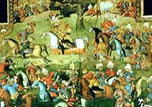Iraq under the Safavids of Iran
The Safavids (1508-34)
On Oct. 21, 1508, Shah Isma'il I, founder of the
Shi'ite Safavid dynasty in Iran, entered Baghdad
at the head of his Kizilbash Turkmen troops, driving out
the Purnak governor. Turning the city over to his chief
of staff, he moved south against the Musha'sha'. As in
the Turkmen period, tribal centrifugalize continued to
dominate the politics of the region.
In Upper Iraq, parts of Diyar Bakr--including
Mosul and the Kurdish regions east of the
Tigris--came under Ottoman control after the
Safavids under Isma'il were defeated by Sultan
Selim I at Chaldiran in 1514. Arabian
Iraq, however, remained in Safavid hands, and the
Mawsillu chieftains, formerly confederates of the Ak
Koyunlu, now in the service of the Safavids,
rose to power in Baghdad between 1514 and 1529. One of
them, Dhu'l-Faqar, or "Nukhud Sultan,"
in fact declared himself independent of the Safavids. The
young Shah Tahmasp I, the son of Isma'il,
retook Baghdad in 1529 and gave it to Muhammad
Sultan Khan Takkalu.
In 1533 Selim's son, the Ottoman
sultan Süleyman I (also known as Süleyman the
Magnificent), set out on his campaign against "the Two Iraqs." On Nov. 18,
1534, he took Baghdad from the Safavid
governor Muhammad Sultan Khan. The city was then
integrated into the Ottoman Turkish empire, except for a
brief Safavid reoccupation from 1623 to 1638. Lower Iraq,
too, was incorporated into the empire by the middle of the 16th century.
As a result of the Ottoman conquest, Iraq underwent
complete geopolitical reorientation westward.


